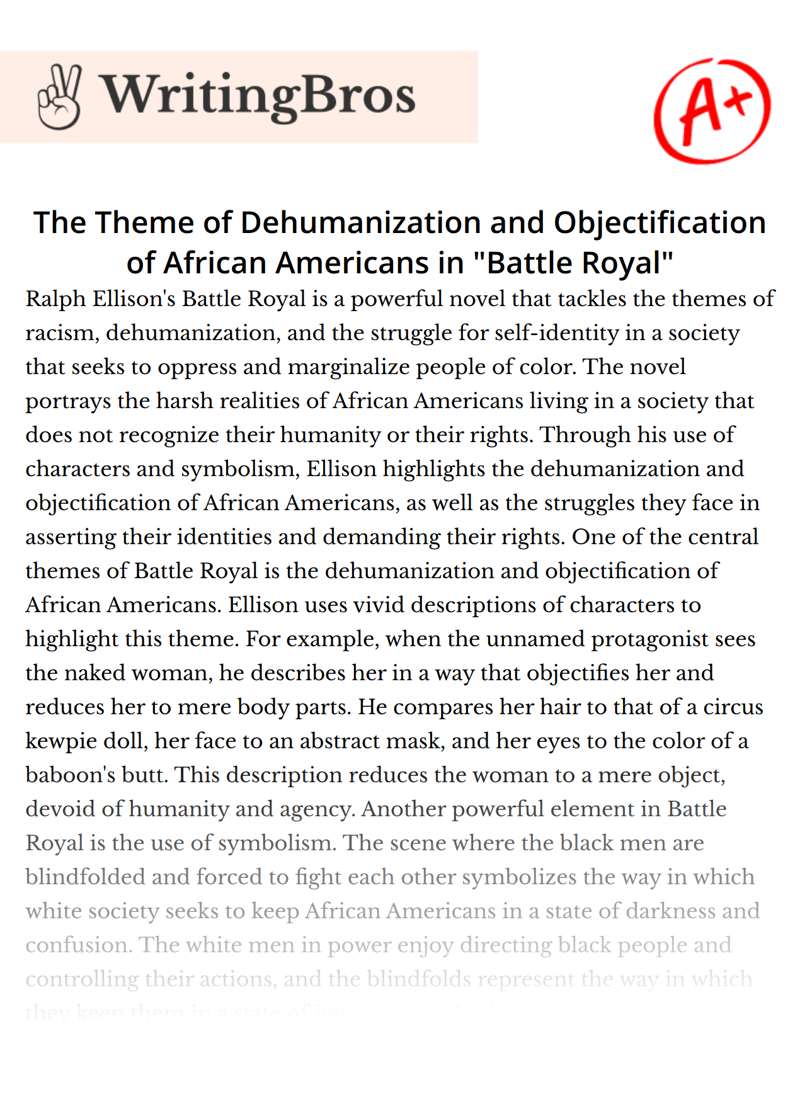The Theme of Dehumanization and Objectification of African Americans in "Battle Royal"

Ralph Ellison's Battle Royal is a powerful novel that tackles the themes of racism, dehumanization, and the struggle for self-identity in a society that seeks to oppress and marginalize people of color. The novel portrays the harsh realities of African Americans living in a society that does not recognize their humanity or their rights. Through his use of characters and symbolism, Ellison highlights the dehumanization and objectification of African Americans, as well as the struggles they face in asserting their identities and demanding their rights.
One of the central themes of Battle Royal is the dehumanization and objectification of African Americans. Ellison uses vivid descriptions of characters to highlight this theme. For example, when the unnamed protagonist sees the naked woman, he describes her in a way that objectifies her and reduces her to mere body parts. He compares her hair to that of a circus kewpie doll, her face to an abstract mask, and her eyes to the color of a baboon's butt. This description reduces the woman to a mere object, devoid of humanity and agency.
Another powerful element in Battle Royal is the use of symbolism. The scene where the black men are blindfolded and forced to fight each other symbolizes the way in which white society seeks to keep African Americans in a state of darkness and confusion. The white men in power enjoy directing black people and controlling their actions, and the blindfolds represent the way in which they keep them in a state of ignorance and subjugation.
The struggle for equality is another major theme in Battle Royal. The narrator's mistake of saying "social equality" instead of "social responsibility" highlights the way in which white society expects black people to be content with their oppressed status. The white men in power look down on black people and do not consider them as equals. The narrator is met with instant displeasure when he mentions "equality," and he is reminded that he needs to know his place. This scene illustrates the challenges that African Americans face in demanding their rights and asserting their identities in a society that seeks to silence and marginalize them.
In conclusion, Battle Royal is a powerful novel that explores the themes of racism, dehumanization, and the struggle for self-identity in a society that seeks to oppress and marginalize people of color. Through his use of characters and symbolism, Ralph Ellison highlights the harsh realities of African Americans living in a society that does not recognize their humanity or their rights. The novel serves as a powerful reminder of the ongoing struggles for equality and justice in our society, and the need to continue to fight against racism and oppression in all its forms.
References
- Ellison, R. (1995). Battle royal. In R. Ellison & J. Callahan (Eds.), The collected essays of Ralph Ellison (pp. 117-133). Modern Library.
- Bradley, A. (2017). Invisible man: A grotesque romance. Modern Language Quarterly, 78(2), 125-149. https://doi.org/10.1215/00267929-3784646
- Sundquist, E. (1993). Invisible man: The black college and other essays (2nd ed.). Oxford University Press.
- Eichelberger, C. (2008). Ellison's invisible man: Invisibility, race, and homoeroticism. Journal of Homosexuality, 54(3), 223-241. https://doi.org/10.1080/00918360801910162
- Howard, J. (2015). "This is a war": Reading the "Battle Royal" chapter of Ralph Ellison's Invisible Man through a Levinasian lens. College Literature, 42(4), 702-720. https://doi.org/10.1353/lit.2015.0047
Cite this Essay
To export a reference to this article please select a referencing style below

